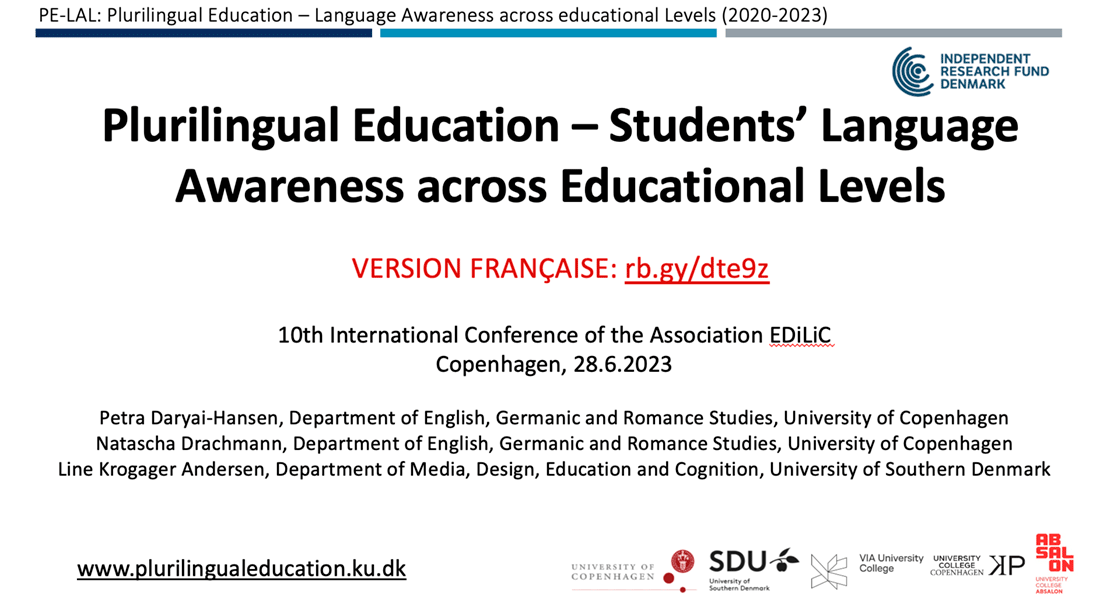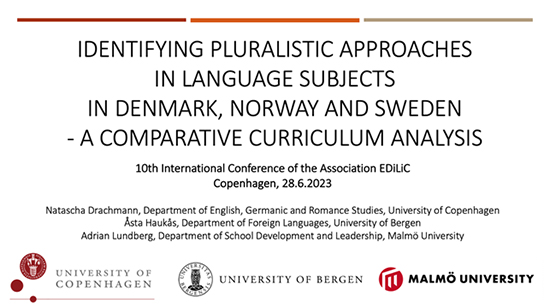Keynote and papers at 10th EDiLiC conference
The PE-LAL team presents final findings from the project at the 10th International Conference of the Education and Linguistic and Cultural Diversity Association (EDiLiC) taking placed at the University of Copenhagen on 28-30 June 2023.
The findings are presented through a common keynote and through two individual papers.
Abstract for keynote by Petra Daryai-Hansen, Natascha Drachmann & Line Krogager Andersen

Starting with an introduction to the PE-LAL project, its qualitative design, methodology and context for the study, the keynote presents a theoretically and empirically embedded operationalization of learners’ LA across educational levels in the context of plurilingual education, developed on the basis of an abductive approach (Dubois & Gadde, 2002; Timmermans & Tavory, 2012) combining previous research and empirical findings from the PE-LAL project. Drawing on Candelier et al. (2010), the operationalization defines the context of plurilingual education as a continuum consisting of three pluralistic approaches to languages and a transversal dimension focusing on learners’ language resources including first languages beyond the language(s) of schooling. Drawing on van Lier (1998, 2004), the operationalisation defines LA as practical language awareness (PLA), metalinguistic awareness (MLA) and critical language awareness (CLA) that can be directed towards nine language levels.
The operationalization shows how an interplay between PLA, MLA and/or CLA takes place occasionally, and the operationalization is concretized through classroom student data covering transitions from primary to lower secondary to upper secondary education. Based on the operationalization, empirical findings from two analytical focus points, including grade 1 (age 7/8) and grade 9 (age 15/16) as well as grade 5 (age 11/12) and grade 11 (age 17/18), respectively, are presented. The findings indicate that PLA, MLA and CLA can be developed by students across educational levels and that the learners’ LA with age reflects a complexification manifested through the LA articulation and the LA language levels. Also, the findings imply that LA is framed by the students’ cognitive development and experiences. In conclusion, the keynote links the operationalization to cognitive development and the concept of experiences and discusses how other external factors appear to have an influence on learners’ LA.
Abstract for paper by Natascha Drachmann, Åsta Haukås and Adrian Lundberg
 In Scandinavia, where all students learn two or more languages in and outside of school, plurilingualism has been embraced as an important goal in language curricula. However, previous research has shown that teachers struggle to understand what plurilingualism is and how it can be implemented (Daryai-Hansen & Albrechtsen, 2018; Haukås, 2016; Lundberg, 2019). Through a qualitative content analysis (Mayring, 2015) on the national curricula for the three main language subjects of schooling in Denmark, Norway, and Sweden the paper seeks to address this lack of clarity by identifying which pluralistic approaches can be found in the respective countries’ language curricula. The theoretical framework for the analysis is the three approaches described in The Framework of Reference for Pluralistic Approaches to Languages and Cultures (Candelier et al., 2007): integrated didactic approach (IDA), intercomprehension between related languages (ICRL), and eveil aux langues (EAL). The analysis shows that there are several similarities across the Scandinavian countries, but also some major differences, showing that plurilingual education in these countries will likely have different learning outcomes for the students. For example, IDA is lacking in the Swedish curriculum, and the goals for ICRL are more ambitious in Denmark than in the other countries. Furthermore, Norway and Sweden include national minority languages in their pluralistic approaches, whereas no attention is given to language diversity in regions with close political bonds to Denmark, such as the Faroe Islands, Iceland, and Greenland.
In Scandinavia, where all students learn two or more languages in and outside of school, plurilingualism has been embraced as an important goal in language curricula. However, previous research has shown that teachers struggle to understand what plurilingualism is and how it can be implemented (Daryai-Hansen & Albrechtsen, 2018; Haukås, 2016; Lundberg, 2019). Through a qualitative content analysis (Mayring, 2015) on the national curricula for the three main language subjects of schooling in Denmark, Norway, and Sweden the paper seeks to address this lack of clarity by identifying which pluralistic approaches can be found in the respective countries’ language curricula. The theoretical framework for the analysis is the three approaches described in The Framework of Reference for Pluralistic Approaches to Languages and Cultures (Candelier et al., 2007): integrated didactic approach (IDA), intercomprehension between related languages (ICRL), and eveil aux langues (EAL). The analysis shows that there are several similarities across the Scandinavian countries, but also some major differences, showing that plurilingual education in these countries will likely have different learning outcomes for the students. For example, IDA is lacking in the Swedish curriculum, and the goals for ICRL are more ambitious in Denmark than in the other countries. Furthermore, Norway and Sweden include national minority languages in their pluralistic approaches, whereas no attention is given to language diversity in regions with close political bonds to Denmark, such as the Faroe Islands, Iceland, and Greenland.
Abstract for paper by Line Krogager Andersen
 This presentation focuses on the emergence of critical language awareness (Fairclough, 1992; Nuñez, 2022) and its relationship to students’ linguistic repertoires (Busch, 2012, 2017) in the context of a plurilingual course on General Language Awareness in Danish upper secondary (Almen sprogforståelse, cf. Daryai-Hansen et al., in progress). Many studies on bilingualism and multilingualism have found that language users with more complex linguistic repertoires (bilinguals and multilinguals) have higher levels of metalinguistic awareness (Bialystok, 2001, 2011; Hofer & Jessner, 2019; Oliveira & Ancâ, 2018). As noted by Kroll and Bialystok (2013), bilingualism is not a categorical variable, and the same can be said of multilingualism. Individuals have different linguistic experiences and backgrounds, and the composition of their linguistic repertoires is highly individualised (Blackledge & Creese, 2010; Cenoz, 2017; Heller, 2007). This presentation investigates the relationship between students’ plurilingual repertoires and their manifestations of critical language awareness on the basis of classroom data collected in the Plurilingual Education project (financed by the Danish Research Council, grant no: 0132-00208B; see Daryai-Hansen et al. 2020). According to Nuñez (2022), the development of critical language awareness is related directly to the linguistic oppression and inequities frequently experienced by linguistic minorities, and thus such minorities might be expected to have enhanced capacities for critical language awareness.
This presentation focuses on the emergence of critical language awareness (Fairclough, 1992; Nuñez, 2022) and its relationship to students’ linguistic repertoires (Busch, 2012, 2017) in the context of a plurilingual course on General Language Awareness in Danish upper secondary (Almen sprogforståelse, cf. Daryai-Hansen et al., in progress). Many studies on bilingualism and multilingualism have found that language users with more complex linguistic repertoires (bilinguals and multilinguals) have higher levels of metalinguistic awareness (Bialystok, 2001, 2011; Hofer & Jessner, 2019; Oliveira & Ancâ, 2018). As noted by Kroll and Bialystok (2013), bilingualism is not a categorical variable, and the same can be said of multilingualism. Individuals have different linguistic experiences and backgrounds, and the composition of their linguistic repertoires is highly individualised (Blackledge & Creese, 2010; Cenoz, 2017; Heller, 2007). This presentation investigates the relationship between students’ plurilingual repertoires and their manifestations of critical language awareness on the basis of classroom data collected in the Plurilingual Education project (financed by the Danish Research Council, grant no: 0132-00208B; see Daryai-Hansen et al. 2020). According to Nuñez (2022), the development of critical language awareness is related directly to the linguistic oppression and inequities frequently experienced by linguistic minorities, and thus such minorities might be expected to have enhanced capacities for critical language awareness.
In the Plurilingual Education project (a multiple case study across educational levels), teaching is designed to promote plurilingual affordances (Krogager Andersen, 2021) for critical language awareness for all students irrespectively of their linguistic background. The exploration of classroom data collected in this project allows for a discussion of the following questions: a) what is the nature of the relationship between students’ linguistic repertoires and their manifestations of critical language awareness? B) to what extent can plurilingual teaching establish affordances for critical language awareness for all students? And c) how may plurilingual teaching activities be designed and transition into mainstream language teaching in ways that promote critical language awareness? Through these questions, we zoom in on continuities and disruptions in language teaching and ideologies as experienced by students in the course on General Language Awareness.
Read conference programme.
